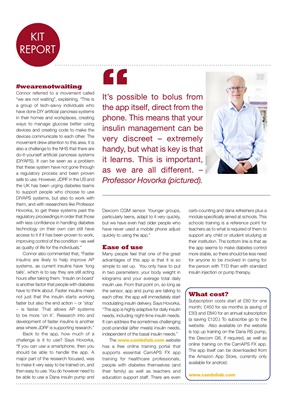
KIT
KIT
REPORT
#wearenotwaiting
Connor referred to a movement called
"we are not waiting", explaining, "This is
a group of tech-savvy individuals who
have done DIY artificial pancreas systems
in their homes and workplaces, creating
ways to manage glucose better using
devices and creating code to make the
devices communicate to each other. The
movement drew attention to this area. It is
also a challenge to the NHS that there are
do-it-yourself artificial pancreas systems
(DIYAPS). It can be seen as a problem
that these system have not gone through
a regulatory process and been proven
safe to use. However, JDRF in the US and
the UK has been urging diabetes teams
to support people who choose to use
DIYAPS systems, but also to work with
them, and with researchers like Professor
Hovorka, to get these systems past the
regulatory proceedings in order that those
with less confidence in handling diabetes
technology on their own can still have
access to it if it has been proven to work,
improving control of the condition ¬as well
as quality of life for the individuals."
Connor also commented that, "Faster
insulins are likely to help improve AP
systems, as current insulins have 'long
tails', which is to say they are still acting
hours after taking them. 'Insulin on board'
is another factor that people with diabetes
have to think about. Faster insulins mean
not just that the insulin starts working
faster but also the end action - or 'stop'
- is faster. That allows AP systems
to be more 'on it'. Research into and
development of faster insulins is another
area where JDRF is supporting research."
Back to the app, how much of a
challenge is it to use? Says Hovorka,
"If you can use a smartphone, then you
should be able to handle the app. A
major part of the research focused, was
to make it very easy to be trained on, and
then easy to use. You do however need to
be able to use a Dana insulin pump and
Dexcom CGM sensor. Younger groups,
particularly teens, adapt to it very quickly,
but we have even had older people who
have never used a mobile phone adjust
quickly to using the app."
Ease of use
Many people feel that one of the great
advantages of this app is that it is so
simple to set up. You only have to put
in two parameters: your body weight in
kilograms and your average total daily
insulin use. From that point on, so long as
the sensor, app and pump are talking to
each other, the app will immediately start
modulating insulin delivery. Says Hovorka,
"The app is highly adaptive for daily insulin
needs, including night-time insulin needs.
It can address the sometimes challenging
post-prandial (after meals) insulin needs,
independent of the basal insulin needs."
The www.cambdiab.com website
has a free online training portal that
supports essential CamAPS FX app
training for healthcare professionals,
people with diabetes themselves (and
their family) as well as teachers and
education support staff. There are even
What cost?
Subscription costs start at £80 for one
month; £450 for six months (a saving of
£30) and £840 for an annual subscription
(a saving £120.) To subscribe go to the
website. Also available on the website
is top up training on the Dana RS pump,
the Dexcom G6, if required, as well as
online training on the CamAPS FX app.
The app itself can be downloaded from
the Amazon App Store, currently only
available for android.
www.cambdiab.com
It's possible to bolus from
the app itself, direct from the
phone. This means that your
insulin management can be
very discreet - extremely
handy, but what is key is that
it learns. This is important,
as we are all different. -
Professor Hovorka (pictured).
"
carb-counting and dana refreshers plus a
module specifically aimed at schools. This
schools training is a reference point for
teachers as to what is required of them to
support any child or student studying at
their institution. The bottom line is that as
the app seems to make diabetes control
more stable, so there should be less need
for anyone to be involved in caring for
the person with T1D than with standard
insulin injection or pump therapy.